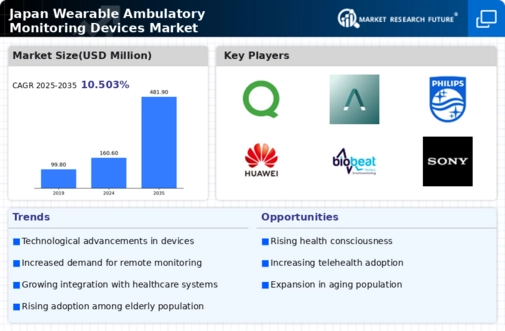Government Initiatives and Funding
Government initiatives aimed at promoting digital health solutions play a pivotal role in the growth of the wearable ambulatory-monitoring-devices market. In Japan, the government has launched various programs to support the development and adoption of health technologies. For instance, funding for research and development in digital health has increased by 25% in recent years. These initiatives encourage innovation and facilitate the entry of new players into the market, enhancing competition and driving advancements in wearable technology. Furthermore, public health campaigns that advocate for the use of wearable devices to monitor health metrics contribute to increased consumer acceptance and adoption, thereby expanding the market.
Rising Health Awareness and Preventive Care
There is a growing trend of health awareness among the Japanese population, which significantly impacts the wearable ambulatory-monitoring-devices market. As individuals become more conscious of their health, they seek tools that enable them to monitor their physical activity, heart rate, and other vital signs. This shift towards preventive care is reflected in the increasing sales of wearable devices, which are projected to reach approximately $1 billion by 2026. The emphasis on maintaining a healthy lifestyle and preventing diseases before they arise drives consumers to adopt these technologies. Consequently, the market is likely to see a surge in demand for innovative and user-friendly devices that cater to this health-conscious demographic.
Aging Population and Health Monitoring Needs
The aging population in Japan is a significant driver for the wearable ambulatory-monitoring-devices market. As the demographic shifts towards an older age group, the demand for health monitoring solutions increases. In 2025, it is estimated that over 30% of the population will be aged 65 and above. This demographic is more susceptible to chronic diseases, necessitating continuous health monitoring. Wearable devices provide a convenient solution for elderly individuals to track vital signs, manage medications, and communicate health data with healthcare providers. The integration of these devices into daily life can enhance the quality of care and potentially reduce healthcare costs, making them an essential component of the healthcare system in Japan.
Consumer Demand for Data-Driven Health Insights
The increasing consumer demand for data-driven health insights is a significant driver of the wearable ambulatory-monitoring-devices market. As individuals seek more control over their health, they are turning to devices that provide detailed analytics and personalized feedback. This trend is evident in the rising popularity of fitness trackers and smartwatches, which offer features such as sleep tracking, heart rate monitoring, and activity logging. In 2025, it is projected that the market for these devices will grow by approximately 15% annually. Consumers are increasingly valuing the ability to access and interpret their health data, which empowers them to make informed decisions about their well-being. This demand for actionable health insights is likely to propel the market forward.
Technological Integration in Healthcare Systems
The integration of advanced technologies into healthcare systems in Japan is a crucial driver for the wearable ambulatory-monitoring-devices market. The adoption of telemedicine and digital health solutions has accelerated, with a reported increase of 40% in telehealth consultations in recent years. This trend encourages the use of wearable devices that can seamlessly connect with healthcare platforms, allowing for real-time data sharing and remote patient monitoring. As healthcare providers increasingly rely on data-driven insights to enhance patient care, the demand for wearable devices that facilitate this integration is expected to grow. This technological synergy not only improves patient outcomes but also streamlines healthcare processes, making it a vital aspect of the market.






















Leave a Comment